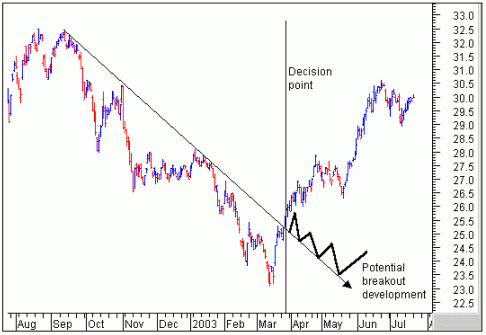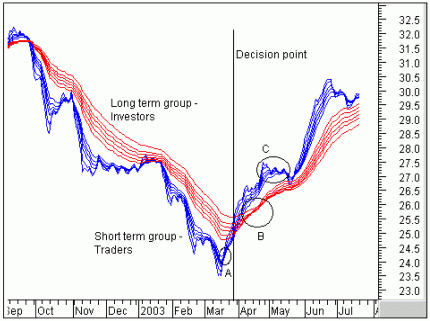These tools tell us about trends, but
they do not help us understand the character
of a the trend. Is the trend weak, or
strong, or stable, or volatile? The Guppy
Multiple Moving Average indicator helpd to
understand this character of the trend
because it captures the changing differences
between price and value.
A crossover delivers two messages about the
market. The first, and most commonly
understood, is a message about price.
Today’s price is higher, or lower, than the
average price over two time frames.
The second message is about value. At the moment in time when the two averages crossover there is a fleeting agreement about the value of the stock. Price is what we pay for a stock and value is what we think the stock is worth.
Generally we try to get stock at a price that is below what we believe is its true value. Changes in value drives the market. As soon as there is agreement about value, then we can expect disagreement. It is human nature.
Imagine a popular newsletter recommended stock XYX as an excellent, sure fire, cannot fail, buy at $1.50. The market is closed and the last traded price for XYX was $1.50. If you wanted to buy XYX tomorrow on the open, would you bid $1.50 knowing that many other people had also read the same newsletter?
With such widespread agreement on value from the people who read the newsletter, you need to bid $1.52 just to get ahead of the crowd. Other readers bid even higher, just to be sure of getting stock. Still others will watch the open of the market, perhaps at $1.55, and then bid ahead of the market at $1.58 to get the stock.
The key point is that where there is
agreement in the market about value, it is
usually followed by disagreement.
We see this in action when we take a group
of moving averages. We assemble a group of
3, 5, 8, 10, 12, and 15 day exponential
moving averages to track this short term
traders think. We cannot know for certain
that these are short term traders, but it
provides a guide to short term movements in
the market. It is convenient to think of
these as representing traders.

The chart shows two characteristics. When
there is widespread agreement amongst
traders about value - when the averages all
converge – it is often followed by an
explosive move as the moving averages start
to move apart. Traders outbid each other to
get hold of stock.
This is the second characteristic of the
chart display. When the averages are very
wide spread - when people get too carried
away about the price of a stock when
compared to value - the price collapses.
This type of chart shows bubbles of short
term excitement.
The market is driven by two groups – traders
and investors. Investor activity provides
stability in a trend so if we can understand
their behaviour we can make a better
decision about the strength of the trend.

We track the inferred behaviour of
investors using a group of 30, 35, 40, 45,
50 and 60 day exponential moving averages.
We see the same pattern with this group.
Think of these as six fund managers. They
all decide the stock is worth adding to
their portfolio. The only way they can get
stock is to outbid their competitors.
Because they often want very large blocks of
stock, they have no choice but to pay a bit
more than the current market price.
To put their analysis into action they have to buy stock on the open market and beat their competitors. The common agreement on value is shattered when they start buying stock. Just like traders, when investors agree about value, it is followed by a disagreement about value. And, at the point of maximum disagreement, the price collapses. Their activity is a fractal repetition of the activity of the traders.
As the chart shows, when we track the
implied activity of both groups - traders
and investors - the Guppy Multiple Moving
Average indicator is particularly useful for
identifying major shifts in the trend. When
both groups converge and agree about value,
then this is a signal for a very major
change or acceleration in the trend. When
only one group gets carried away - usually
the traders - we know how much impact they
are likely to have because the Guppy
Multiple Moving Average shows us where the
long term agreement of values lies.
In more advanced application of the Guppy
Multiple Moving Average the relationship
between each of the groups is used to help
determine the type of trading opportunity.
It is also used to evaluate the potential
for a trend break to succeed. These aspects
assist traders in making better decisions
about the best trading approach to use with
each opportunity.
This
powerful tool helps traders to understand
the mood of the market. Unlike just two
moving averages, what is important is not
the price reading, but the relationship
between the way the two groups value the
stock in the current market.




